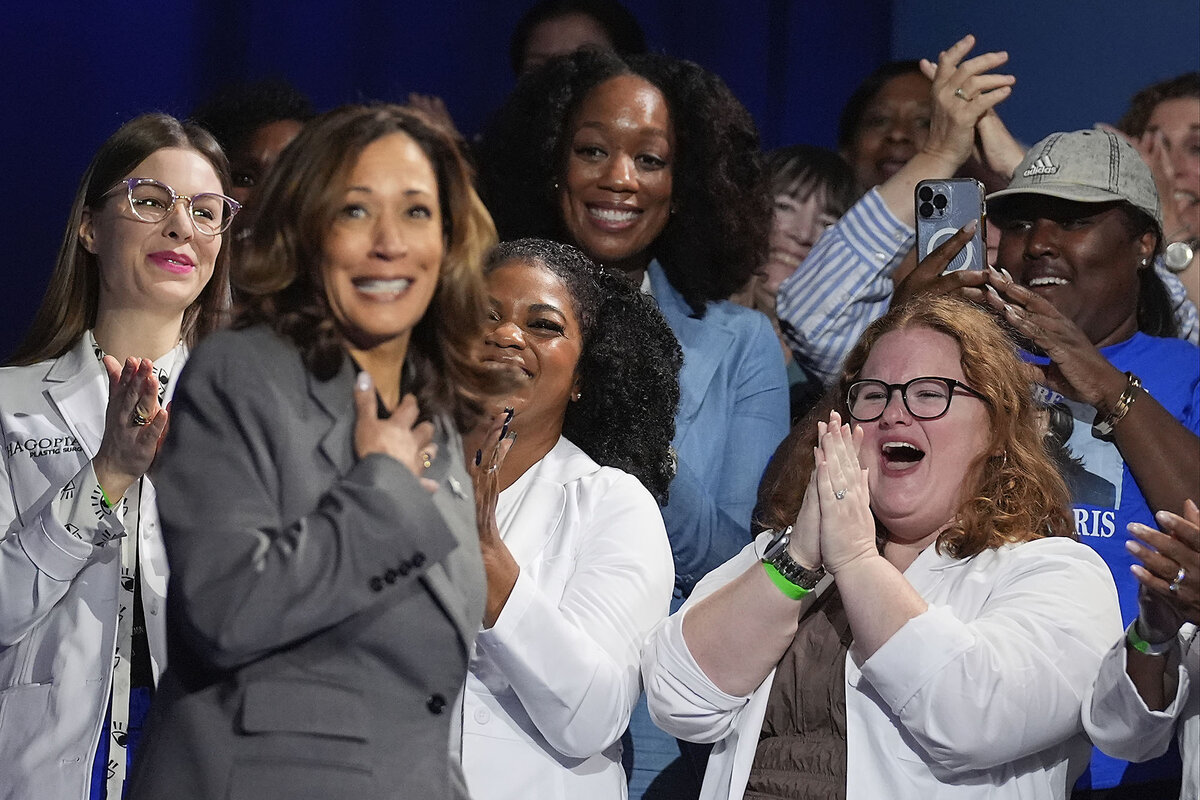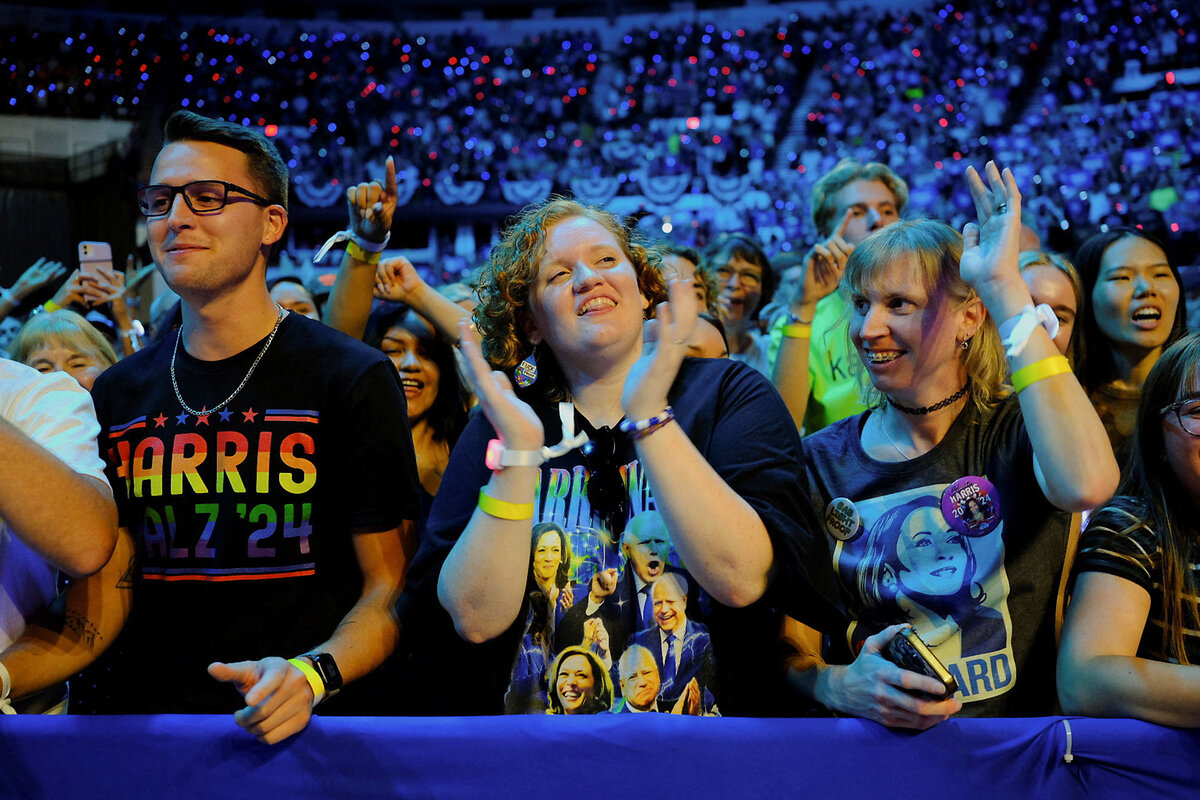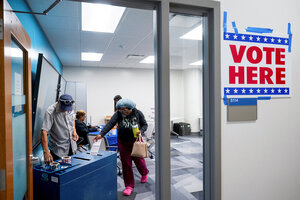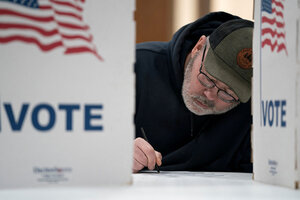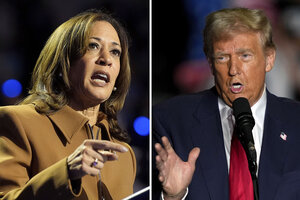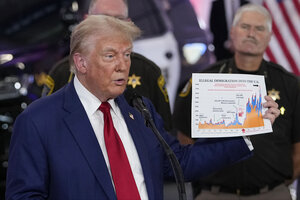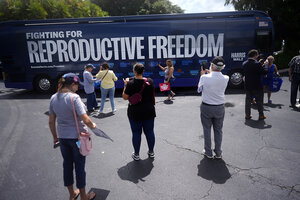Young women and men are diverging on politics. Why this gender gap matters.
Loading...
Every U.S. presidential election since 1980 has had a gender gap. And with just weeks to go before November’s vote, this year is no different: Polls show a majority of female voters prefer Vice President Kamala Harris, while a majority of men prefer former President Donald Trump.
Among the youngest subset of voters, however, that gap is looking more like a chasm.
Why We Wrote This
During the Trump and Biden administrations, young women lurched left on abortion, the environment, and guns, in contrast to young men. News events drove some of those shifts, along with Generation Z’s reliance on social media, with its algorithm-driven feeds, for information.
An August New York Times/Siena College poll of swing states found women under 30 years old favoring Ms. Harris by almost 40 points while men of that same age group favored Mr. Trump by 13 points. A Harvard poll released this week found 70% of young women across the United States backing the vice president, compared with 53% of young men.
The trend could impact far more than this election – suggesting a future red-blue divide shaped more by gender than by geography. If women in the rising generation are becoming dramatically more liberal, while men stay closer to the middle or even move right, that has implications not just for politics but also for dating, marriage, and social cohesion overall.
“I don’t think this is going to be one of those things we look back on and say, ‘Oh, we made a big fuss over this for nothing,’” says Elaine Kamarck of the Brookings Institution.
At Oglethorpe University, outside Atlanta, Ashleigh Ewald says her conservative-leaning professors are all predicting a Trump victory this fall. But she thinks they’re overlooking a key factor.
“What they don’t understand is that Gen Z is a force to be reckoned with,” says Ms. Ewald, a senior studying political science. That’s especially true, she adds, when it comes to women in Generation Z like herself.
Every U.S. presidential election since 1980 has had a gender gap. And with just weeks to go before November’s vote, this year is no different: Polls show a majority of female voters of all ages prefer Vice President Kamala Harris, while a majority of men overall prefer former President Donald Trump.
Why We Wrote This
During the Trump and Biden administrations, young women lurched left on abortion, the environment, and guns, in contrast to young men. News events drove some of those shifts, along with Generation Z’s reliance on social media, with its algorithm-driven feeds, for information.
Among the youngest subset of voters, however, that gap is looking more like a chasm.
An August New York Times/Siena College poll of swing states found women under 30 years old favoring Ms. Harris by almost 40 points, while men of that same age group favored Mr. Trump by 13 points. Put another way, 67% of young women said they would support Ms. Harris, compared with just 40% of young men – a 27-point gender gap that outranks the divide for all other age groups.
A poll released this week by Harvard’s Institute of Politics found even higher support for Ms. Harris across the United States among women under the age of 30 – with 70% of them backing the vice president over Mr. Trump. That same poll reported 53% of men under 30 nationwide supporting Ms. Harris.
Mr. Trump has been improving his margins among younger men who consider themselves “politically homeless” and are open to Republicans’ appeals on cultural issues and masculinity, says Richard Reeves, president of the American Institute for Boys and Men. But young men’s drift to the right was predated by an even bigger shift of young women in the opposite direction, he adds.
Having come of age during Mr. Trump’s presidency, the #MeToo movement, and the overturning of Roe v. Wade, many young women say they are ready for a second wave of feminism to take back the nation’s politics. When Ms. Harris replaced President Joe Biden as the Democratic nominee, the party’s support among young women surged – something the Harris campaign has been quick to capitalize on through social media and what was dubbed the first “Influencer Convention” as she was nominated in Chicago this summer.
Some analysts caution that polls represent only small slices of the electorate, and those slices shrink even further, sometimes to just a few hundred respondents, when zooming in on one demographic group within the poll results. Still, the widening gender gap among young people has appeared consistent across polls. It’s a trend that could impact far more than just this year’s presidential election – suggesting a future red-blue divide that may be shaped more by gender than by geography. If women in the rising generation are becoming dramatically more liberal while men stay closer to the middle or even move to the right, that could have profound implications not just for politics but also for dating, marriage, and social cohesion overall.
“I don’t think this is going to be one of those things we look back on and say, ‘Oh, we made a big fuss over this for nothing,’” says Elaine Kamarck, a senior fellow at the Brookings Institution.
Shifting left on abortion, environment, guns
Although young people are typically less likely to vote than older generations (only 38% say they are “almost certain” they will vote in November, compared with 49% to 64% of older generations who say the same), Gen Z voters attend political rallies and volunteer at higher rates than older Americans.
“I went to my first march with my mom, my sister, and my dance friends the year that Trump decided to run,” says Audra Clear, a senior at Gannon University in Erie, Pennsylvania, who was in eighth grade at the time. “That was the first time that I truly felt like I cared about anything other than myself.”
Recently, Ms. Clear has been helping to spread the word online about an upcoming Women’s Freedom Rally in the city of Erie, a critical swing county in what may be the most critical swing state this fall. Like Ms. Ewald, Ms. Clear says abortion rights is the top issue motivating her to vote in November.
A Gallup analysis from earlier this month found that women between the ages of 18 and 29 lurched leftward during the Trump and Biden administrations on the issues of abortion rights, the environment, and guns, helping to push their overall political leanings to the left. Between 2001 and 2016, around 30% of young women self-identified as “liberal,” a rate that was 3 to 5 points higher than for young men. Between 2017 and 2024, however, that number went up to 40% – 15 points above their male counterparts.
The fact that young women, regardless of educational attainment or race, are citing specific policies like abortion as driving their liberal identity makes the shift “substantive,” says Lydia Saad, director of U.S. social research at Gallup.
“It’s not just a [new] comfort level with the term ‘liberal,’” says Ms. Saad. “They are adopting more liberal positions, and are doing so to a stronger degree.”
Beyond events such as the Trump presidency and the Supreme Court’s 2022 ruling that overturned a national right to abortion, Ms. Saad and her fellow researchers say it’s too early to know definitively what’s causing the shift. But Americans’ increasing reliance on social media for news may have “influenced young women differently,” they write.
“People my age get their news from social media,” says Ms. Ewald. “And I think that social media is on Kamala’s side. Her speeches have turned into whole memes.”
The social media effect
The youngest generation, not surprisingly, spends the most time online – with one survey finding that over 60% of Gen Z spends at least four hours a day on social media, and evidence suggesting that young women are even more glued to their phones than young men are. That’s especially true when it comes to TikTok.
“This is being called the ‘TikTok election,’ so if we are going to look somewhere [to understand the Gen Z gender gap] we might want to start there,” says Zeve Sanderson, director of New York University’s Center for Social Media & Politics.
Other social media sites like Facebook have a “social graph structure,” in which users follow friends and family and they exist in similar online spaces. But on sites like TikTok, algorithms dictate feeds, making the content more tailored – meaning young women often see totally different content than young men do. Often, the two aren’t even on the same sites. Young men spend more time in online spaces like Twitch or video game chat rooms, says Mr. Sanderson, where different conversations can be happening altogether.
Recognizing an opportunity with young male voters (another Harvard poll this spring found that before Mr. Biden dropped out of the race, Mr. Trump was running just 6 points behind him among young men, after trailing by 26 points in 2020), the Trump campaign has leaned into these alternative spaces. Mr. Trump has appeared with influencers such as Adin Ross, Logan Paul, and Theo Von, who are popular among young men, including conservative-leaning ones in particular.
But Mr. Reeves thinks Republicans’ incremental success with younger men has more to do with Democrats’ prioritization of young female voters and their concerns.
“Right now on the cultural level, there is a sense that the right and Republicans are more attuned to men,” says Mr. Reeves. “Young men are struggling in ways that are different to young women. ... And it feels like there has been a decision among Democrats that they were going to win with the votes of women, so they are more reluctant to campaign on issues of importance to young men.”
Democrats could be doing more to highlight the Biden administration’s infrastructure bill, notes Mr. Reeves, and the jobs that it is creating for young men in particular.
As successful as KamalaHQ (the Harris campaign’s TikTok account) has been in connecting with younger voters, Ms. Clear agrees that the vice president could do a better job reaching young men. She’s hopeful some young men will participate in the Erie Democrats’ women’s rally on Saturday. Despite the name, she says, it’s not meant to be a “women-only” event, but rather one that’s focused on one of the most important policy issues of the 2024 campaign.
“I think there will be more men there than we think,” says Ms. Clear. “They may be husbands or boyfriends – they are there and getting educated.”







